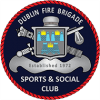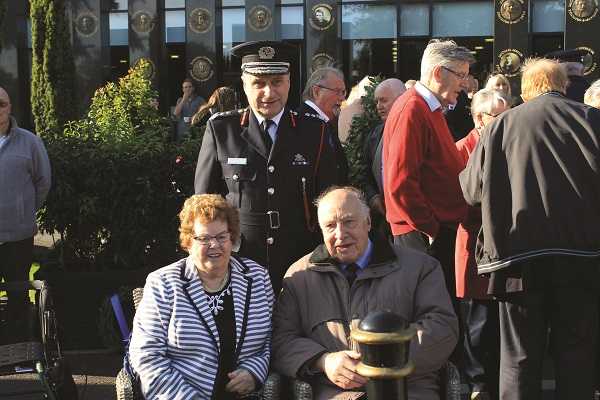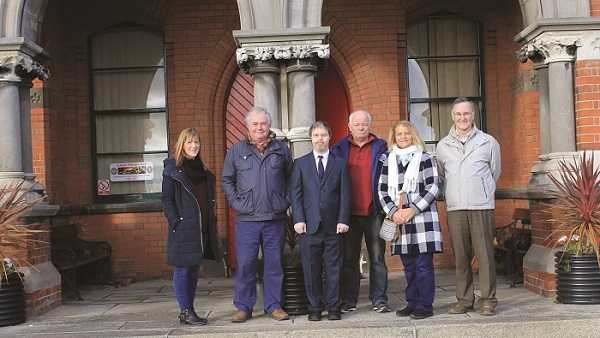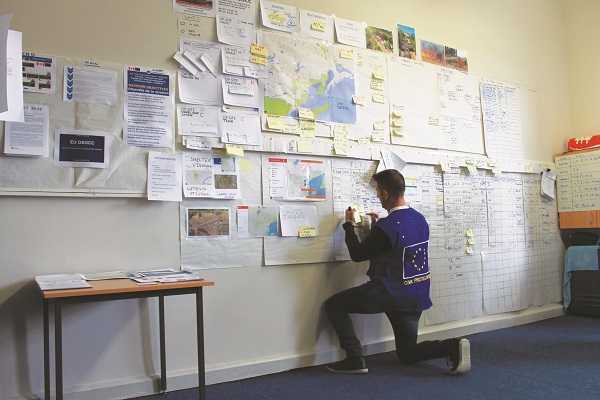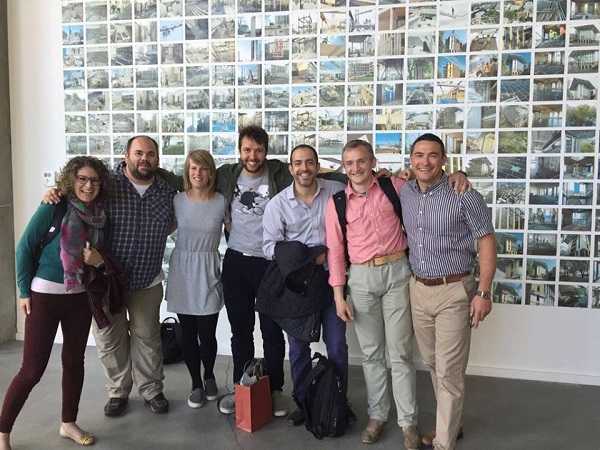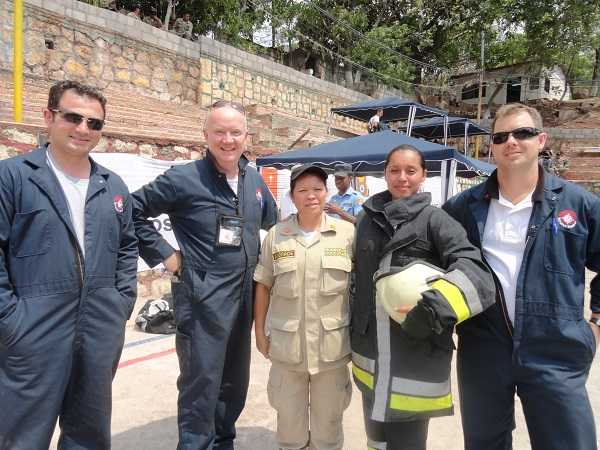Brendan Lodola reflects on a recent cycling trip to Tuscany, a wonderful physical tonic, and an extraordinary outing in the beautiful Tuscan countryside.
Tuscany is one of the heartlands of Italian cycling and, having cycled in Italy for the past few years, an opportunity to share my wonderful experience is precisely what I had in mind when I decided to try gather a group of enthusiastic cyclists from DFB to ride through this beautiful part of the world. The group who came on this trip could be forgiven for thinking that this would be a leisurely spin over rolling hills, dropping into Tuscan village cafés, sipping Italian morning espresso, lazing over lunches in medieval towns and sloshing back one or two glasses of Chianti Classico in the local vineyards. That wasn’t quite my plan!
Little did they know that they would take in the four corners of Tuscany, conquering sections of the eight and ninth stages of the 2016 Giro D’Italia, stepping in and out of the Strada Bianche professional route (which starts and finishes in the medieval town of Siena) and covering part of the terrain of the L’Eroica amateur route over its white gravel roads which starts and ends in the town of Gaiole, not far from our base. With six months of training in Dublin, the Wicklow Mountains and further afield, we were ready for the challenge, or so we thought! These hills are described as rolling, but include climbs of over 20 per cent and long drags that go on for miles with decent gradients. This was going to be four consecutive days of cycling, more than 400 kilometres right in the thick of the hills.
After our journey from Pisa airport it was great to arrive at our base, Norcenni Girasole, warmly greeted by Paulo and his staff. Villa Norcenni, a rustic Tuscan villa and villino, is set in the heart of the Chianti hills with spectacular views of the surrounding countryside. We settled into our rooms and headed down to the restaurant where we were greeted by Claudia, Maria and Oanna who would look after us for the five nights. We had been travelling from early that day, so we were hungry and ready for some local Italian cuisine and we were not disappointed – traditional food at its best, washed down with a glass of Chianti Classico.
Siena
The next morning we strolled down for breakfast, the sun taking the edge off the early morning chill. Sitting, discussing the day ahead over coffee, there was a buzz in the air. Everyone was excited with what the day would bring. Our bike supplier Marco was spot on time again to set up everyone with their full carbon road race bikes. We had Jimmy and Domo (the backup support team) ready and waiting with the support car full of food and water – nothing could dampen our enthusiasm for the day’s cycling. We were off! As we left Norcenni we took a left, straight onto a 10km drag, climbing past the small villages of Ponte Agli Stolli and Dudda. We were immersed within the historic olive groves, honey-coloured stone farmhouses and immaculately maintained rows of vines down sloping hills, with dense forests as far as the eye could see. What an opening to a day’s cycling.
We pushed up past our first peak, with Ciaran and Barry biting on the bit, then prepared for our first long descent into Greve! Dave O’Toole wove in and out, changing positions, capturing each rider as they descended down the winding roads at great speeds with the GoPro fixed to his seat post. It promised to be a special piece of footage, hopefully available on YouTube soon. We would get to climb up this 20km descent another day. Greve in Chianti was the finish of the ninth stage of the 2016 Giro D’Italia and we were about to cover a good section of that stage through the towns of Panzano and the fortress town of Castellina in Chianti. This is where we would try to contact our support team while taking a couple of snapshots of Mick and his big Gallo Nero on our way to Siena.
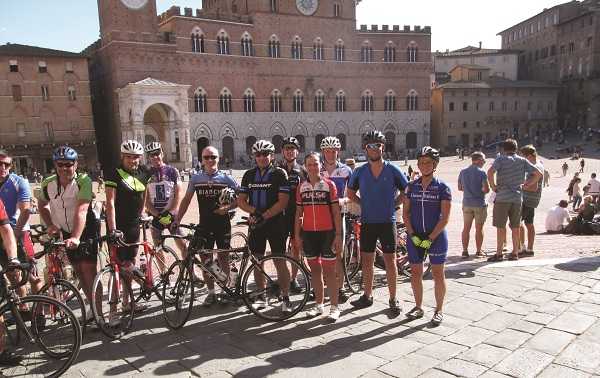
Piazza del Camp, Siena
Eventually we got on our way again with some big climbs towards a region between San Leonino and Topina, which I have to say took my breath away. A classical image of Tuscany rolled into view, with lines of cypress trees standing tall on driveways leading up to hillside estates, small olive groves sitting next to symmetrical lines of vines sloping down the rolling hills towards us, and hilltop houses and towers covered in terracotta tiles with fading hills behind. Did our multicoloured mob of road cyclists know we were, and would be for the next four days, riding through one of the most beautiful parts of the world? With all that in mind we still had 35km of hills to climb before lunch in Siena. Piazza del Campo, the venue for the Palio di Sien, where jockeys ride bareback circles of the piazza on thick layers of dirt, was a welcome restful haven. This magnificent medieval piazza is a focal point for the Italian cool with its narrow cobbled streets and stylish coffee shops surrounding the piazza. After a few tellings off from the locals because we were cycling on the pedestrian streets, we arrived at the Ristorante Alla Speranza. The sun beamed down as we had a few moments to absorb the historic Gothic architecture of the arena.
After much needed sustenance for the homeward stage, and with some tired legs, we gathered our bikes with a little encouragement from the local carabinieri. They didn’t like our 15 bikes propping up the historic pillars! We eventually reached our destination after a bit of assistance from Garmin, through challenging hills and parts of the L’Eroica route. This is a vintage race held every year from the town of Gaiole where cyclists dress up in vintage gear and ride vintage bikes over white gravel and tarmac roads. As we made our way down long descents towards Montevarchi the light was starting to fade, so we pushed it hard on the flat through San Giovani and on home to Norcenni. We covered nearly 140km with an elevation of just under 2,400m, with a lot of tired legs.
[adrotate group=”2″]
Caprese Michelangelo
Another beautiful day greeted us the next morning as we were about to take on a round trip of 150km to the birthplace of Michelangelo in Caprese Michelangelo. This was to be a route with a few drags and then a steep climb before we reached Caprese. Little did we know how much of an adventure the day was going to be!
We started out from Norcenni and turned right down the 4km descent into Figline Valdarno, the local town, with everyone feeling good after the spin yesterday. With barely 10km completed we came across our first obstacle; a road that finishes on one side of a stream and starts again on the other, without a bridge! And so the slagging began. We crossed the river with bikes over our shoulders and continued our spin on our first taste of the controversial gravel roads. “Do you know where you’re going Lodola?” echoed more than once from the back of the double line of 15 cyclists. “Of course I do, and I didn’t even charge you extra for the gravel,” I replied. You can imagine the response.
A little more concentration was required on the 5km of gravel before we reached a smooth surface again. We continued on and had our first bike casualty. Five of Barry’s spokes failed (nothing to do with all the bunny hopping he was doing) and we had to pull in and call for the backup team who were on the scene in minutes. After they finished their cappuccino of course! With the bike and rider in the support vehicle we began a section of stage eight of the 2016 Giro from Quarata to Anghiari with a little unexpected detour.
After contacting the transport department and arranging to meet them for a pit stop near Chiassa Superiore, we were fuelled up and began to head towards our first taste of a real Strade Bianche road (which I have to say was not in the original plans). I felt an air of disbelief from the group as the Garmin was bleeping for a left turn off the smooth surface. There were a few expletives heard in the background, not mentioning any names, but we pressed on. On such a bright day the white gravel really reflected back at us as we steadily munched our way along its surface. I was hoping that this would just be a few hundred metres and then we’d get back to the smooth stuff. It wasn’t to be. It took a while to adjust to the uncertain feel beneath the tyres. The road started to kick up in the thick of the forest and it became more difficult to control our bikes. “I’m expecting a bear to jump out from the trees and give me a hug,” a concerned Peter White explained.
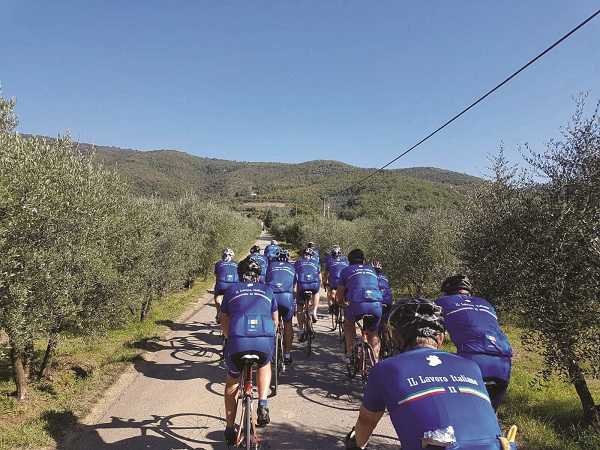
Our first experience of a Strade Bianche road
This road had concealed sloping edges that could send you slipping off the road into the ditch if you strayed too close to the edge. The tight cambered corners have ridges embedded into their surface from the weight of heavy farm vehicles, which force you to ride wide rather than lose speed and rhythm on the bumpy inside line. This forced you to relax your body using your arms as natural suspension. You also learned to pedal smoothly and stay seated, which was more difficult – standing out of the saddle was not an option as the rear wheel would spin. Anticipating and absorbing any changes in the surface without overreacting or disrupting your tempo was a must or you ended up on your backside.
The only sound to be heard on the car-free road was laboured breathing; we had climbed over 500m in only 8km. We regrouped at the top of the climb with some pretty tired legs and a few looks of disbelief that we actually took that on and got to the top unscathed. Fausto Coppi and his arch-rival Gino Bartali would have been proud of us. They are probably the most famous Italian cyclists who raced in arguably the most famous Giro of them all, the 1949 Giro D’Italia. Tuscany was the home of Bartali, Coppi was from neighbouring Piedmont, and they were fierce rivals. With a few punchy climbs and a couple of steep sections of descent, which were pretty challenging, concentration was a must as we approached Caprese. Not surprisingly Michelangelo was not at home and the town was having a nap, so our lunch stop would be a short one.
Time was not on our side so a steady but determined mindset was needed to set off positively homeward bound, as this would be one of the most challenging sections of the day. Not only were we tired from our morning climbs, but we would encounter some more significant hills. Searching for somewhere to eat on the way home we came across a welcome osteria which could cater for 15 very hungry cyclists. A delicious bowl of pasta ragu freshly made by our host, some local chunky pieces of bread and aqua frizante (sparkling water) was just the tonic to recharge our batteries as we prepared to beat the fading light. With one more pit stop near San Giustino Valdarno, Dave P Byrne and Mick Whelan would get on their way with the transport team to get the other cars.
The final stretch of the day’s ride was about sheer determination and the group pushed hard along the relentless rolling tarmac, but we were forced to succumb to the light and pull into a mountainside town called Loro Ciuffenna and wait for transport. This was certainly a longer, more lively and interesting day’s cycling, where fitness and skill on the bike was very evident. There would be some very tired legs in the morning!
Montefioralle
The weather on our third day was once again sublime. There was a slightly pensive mood over breakfast brought about by our increased awareness of what we were about to let ourselves in for. On paper, this was to be the most difficult of the four days, with a loop of over 125km with nine big climbs and a total elevation of more than 3,500m without too many flat sections. As arranged the day before, Marco arrived at reception with a new wheel to restore our group to full strength. Between one thing and another we were behind time. With a sense of joy because of the fantastic countryside, and apprehension because we knew the terrain, we set off left up the Via di Norcenni, our legs adjusting again to a hard day’s cycle. We had covered this climb on the way to Greve on the first day and we looked forward to the upcoming long descent. In the arched loggias of the main piazza in Greve, while sipping on our espressos and cappuccinos, it was apparent that time would not allow us to get to reach San Gimignano before dark. Disappointed in not being able to see this medieval town, a decision was made to do a much harder but shorter course. Some would do hill repeats into a beautiful little town called Montefioralle, while a few others would, let’s say, have a longer brunch, then head back and practice for the evening tennis match. A likely story!
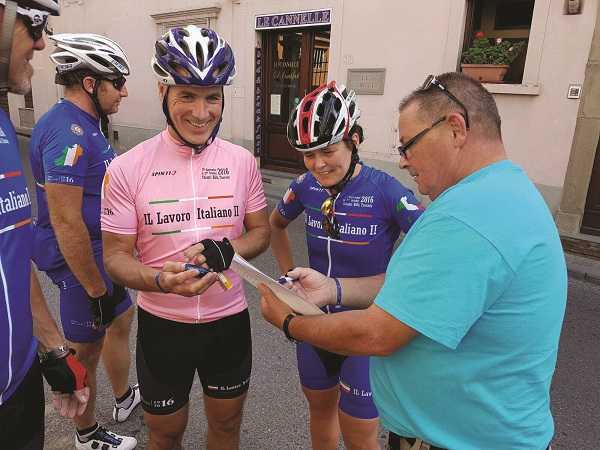
The Garmin facing off against our transport department’s trusty map
The transport team had already done a recce to the town of Montefioralle and beyond, warning us that even the support vehicle found it hard climbing the hills which led to this town. They weren’t joking – in 32km we climbed 930m. To take a passage from Dino Buzzati’s coverage of the 1949 Giro: “Surely it was a crime, in a sense, to make use of such enchanting scenery for such unrewarding, bestial labour”. I thought there would be a crime committed when we reached the top with the looks I was getting!
Once again vineyards, cypress trees, hilltop villages and villas were regular features of the surrounding countryside, providing a welcome distraction from the relentless hard pedalling! Montefioralle (sometimes claimed to be the birthplace of the explorer Amerigo Vespucci), is a magnificent medieval village with narrow cobbled streets lined with small entrances to traditional shops and restaurants. Aromas of local Tuscan cuisine filled the air as we painfully climbed these great hills, giving us something to look forward to on our way back down later for lunch.
We welcomed the sight of the Taverna del Guerrino where we stopped for some lunch. Sitting on the veranda, we had a few moments to absorb this postcard-perfect part of the Tuscan landscape and enjoyed a well deserved meal of pasta, antipasti, dolci and a small glass of vino. Fuelled up and ready for the 20km climb on the way back that we had come down on the first day, we set off knowing the pool was waiting, not to mention the Dún Laoghaire tennis aces ready to give us a display of their ability. The two professional players were brought in to give the group a tennis demonstration – Domo ‘Statue of Liberty’ Campbell and Mick ‘Good at Corners’ Whelan.
It was obvious from early on that the opposition wasn’t up to much, with Dave ‘Good on the Dance Floor’ Kenyon and Ciaran ‘Shep’ McConnell not returning any serves. It was decided to split the teams up with one professional playing with one of the novices. This livened the game up a bit and drew a small crowd of onlookers. The serves were cutting and the slagging was quick and accurate. It wasn’t long before both teams warmed up and got into the cheating at full match pace. This encouraged the onlooking crowd to join in the banter much to the amusement of any passing onlookers. Eventually, after a couple of fiercely disputed sets, a ceasefire was called with all parties retiring to the bar for some well earned wine tasting.
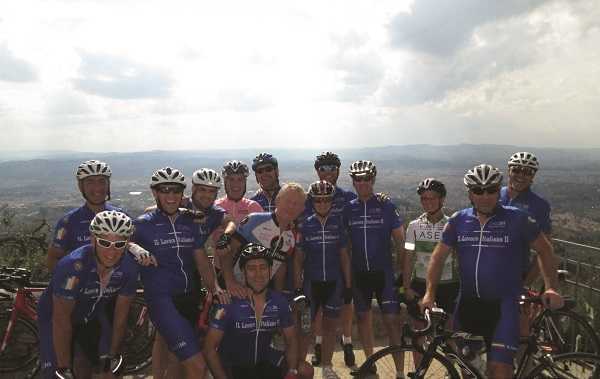
Overlooking Florence from Fiesole
Fiesole
The final day’s cycling would be all smooth roads, as I knew this route from previous years. We would cycle an 85km loop with a 1,250m elevation gain – flat compared to the previous three days. We were heading north into a town called Fiesole which overlooks the city of Florence. With some tired legs and bodies out there a casual pace would be a welcome relief. But we were in the Chianti hills after all, so there were still hills to climb. “Pull it back half a click” was heard more than once through the group and the ones who didn’t say it were thinking it!
A long downhill brought us to the start of the mayhem of Florentine traffic. Surprisingly we got through without incident, apart from a few expletives from the local drivers. One more long drag would get us to the finishing town of the 2014 world championships, Fiesole. The mystical beauty of Fiesole, less than 10km outside of Florence, encompasses centuries of history and it is amazingly well preserved. Largely unknown by many, this small town hides a wealth of surprises including the green hilltop where Leonardo da Vinci first experimented with the concept of flight, and the Roman amphitheatre that still serves as a stage for the Estate Fiesolana summer events. We were greeted with O Sole Mio by a local while having lunch, and we sang along with our version, Just One Cornetto! The last stretch of the final day’s ride would give us some nervous -15 per cent to -20 per cent descents out of Fiesole, with very tight hairpin turns requiring alł of our concentration. We cycled back for the last time to Norcenni in relative silence with the occasional bit of encouragement shared. There was just one more kilłer 3km climb left up to our base and there was still a lot left in some legs for a token race. The jury is still out on that one!
This was definitely a trip to remember. After what had seemed like torture at times, I think that there was a great sense of achievement. This group covered more than 400km over four days, on very tough terrain, with more than 20 hours in the saddle conquering some of the steepest hills you can find. Pretty heroic I think! So with that in mind I’d like to say that it’s the group that makes the trip, not the trip that makes the group, so well done everyone and thanks a million.
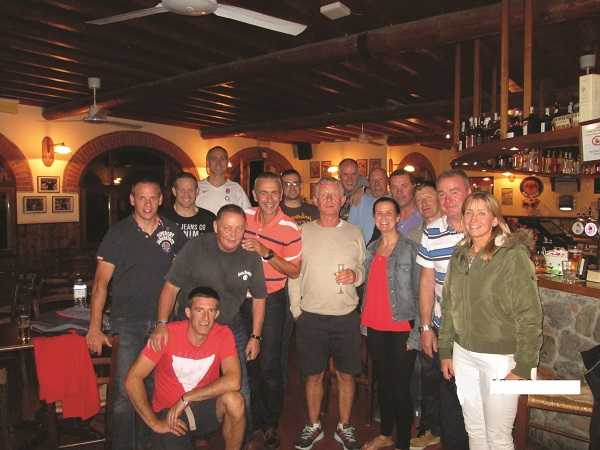
Hard earned refreshments in Siena
On behalf of the group, I’d like to say thanks to Dublin Fire Brigade, Dublin City Council and Dublin Fire Brigade Sports and Social Club for their support. A big thanks to Liz Hanley for organising the fabulous cycling gear, to Mick Whelan and his brother-in-law for their support, and to Jimmy and Domo from the transport dept. Thanks also to CFO Pat Fleming, the Red Torch Restaurant, and everyone at Norcenni Girasole for looking after us so well. Next it was time to have a few well deserved drinks and maybe a twirl or two on the dance floor. Until 2018 then, salute!
